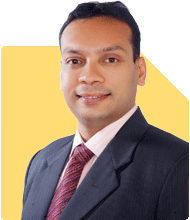Ramalingam Kalirajan |6504 Answers |Ask -Follow
Mutual Funds, Financial Planning Expert - Answered on Jul 06, 2024
He has an MBA in finance from the University of Madras and is a certified financial planner.
He is the director and chief financial planner at Holistic Investment, a Chennai-based firm that offers financial planning and wealth management advice.... more

Hi am 34 years old and I am salaried employee and will be leaving job next 3 months and settle down in hometown. I have 25 Lakhs in FD, 3laks in ULIP and I have 15 lakhs in EPFO. 10 lakhs surplus available with me. Pls advise me with financial goals for the above mentioned amount. I can manage my expenses by own. Need RoR of 15 to 20 % annum on the amount which I have.
Analyzing Your Current Financial Position
Fixed Deposits (FD)
You have Rs. 25 lakhs in FD. This is a safe investment but offers lower returns compared to other options.
Advantages:
Safety: Bank FDs are secure with low risk.
Predictable Returns: Guaranteed returns over a fixed tenure.
Disadvantages:
Low Returns: Typically, FDs offer returns that may not beat inflation.
Lack of Liquidity: Withdrawing before maturity can incur penalties.
Recommendation:
Since you seek higher returns (15-20% per annum), consider reallocating some funds from FDs to more growth-oriented investments. FDs can still serve as a safety net or emergency fund.
Unit Linked Insurance Plan (ULIP)
Your Rs. 3 lakhs in ULIP provide both insurance and investment but may not be the most efficient way to grow your wealth.
Advantages:
Dual Benefit: Combines insurance and investment.
Tax Benefits: Offers tax deductions under Section 80C.
Disadvantages:
High Charges: Premium allocation and fund management charges reduce net returns.
Lock-in Period: Funds are tied up for at least five years.
Recommendation:
Evaluate if ULIP aligns with your long-term goals. If not, consider surrendering it and reinvesting the amount into more flexible and higher-yielding options like mutual funds.
Employees' Provident Fund (EPF)
Your Rs. 15 lakhs in EPF provide a steady, low-risk return with tax benefits.
Advantages:
Safety: Government-backed with stable returns.
Tax Benefits: Contributions, interest, and maturity proceeds are tax-free.
Disadvantages:
Lower Returns: Conservative returns compared to equity investments.
Limited Access: Premature withdrawals are restricted to specific circumstances.
Recommendation:
Continue with your EPF contributions for its stability and tax benefits. It's a solid component of your retirement corpus.
Surplus Funds
You have Rs. 10 lakhs as surplus. This is an excellent opportunity to boost your investment portfolio and seek higher returns.
Recommendation:
Invest this amount in diversified mutual funds, which can potentially offer higher returns compared to traditional savings.
Setting Financial Goals
Short-Term Goals
Emergency Fund: Maintain a fund to cover 6-12 months of expenses in liquid assets like savings accounts or short-term debt funds.
Insurance Coverage: Ensure adequate health and life insurance to protect your family from unforeseen events.
Long-Term Goals
Wealth Creation: Aim for investments that can grow significantly over time.
Retirement Planning: Build a corpus that provides financial independence during retirement.
Future Expenses: Plan for significant future expenses like buying a home, children’s education, or starting a business.
Crafting a Strategy for Higher Returns
Diversifying Your Investments
To achieve your desired rate of return (15-20% per annum), diversification is key. Diversifying reduces risk and enhances returns.
Recommended Allocation:
Equity Mutual Funds: 60-70%
Debt Funds: 20-30%
Liquid Assets: 10-20%
Investing in Equity Mutual Funds
Equity mutual funds offer exposure to the stock market and are managed by professional fund managers.
Advantages:
High Returns: Potential for significant growth over the long term.
Professional Management: Experts handle the investment decisions.
Diversification: Spread across various companies and sectors.
Recommendation:
Invest in actively managed equity funds. These funds are managed by professionals who can make timely decisions to maximize returns. They are more adaptable to market changes compared to index funds, which follow a set index and cannot capitalize on market opportunities.
Benefits of Actively Managed Funds:
Expertise: Fund managers adjust portfolios based on market trends and economic forecasts.
Flexibility: Able to switch investments to seize better opportunities or reduce exposure to underperforming sectors.
Potential for Higher Returns: Actively managed funds aim to outperform the market index.
Avoiding Direct Stock Investments
While you can invest directly in stocks, this approach requires significant time, knowledge, and risk tolerance.
Disadvantages of Direct Stocks:
High Risk: Stock prices can be volatile and unpredictable.
Time-Consuming: Requires constant monitoring and analysis.
Lack of Diversification: High risk if investments are concentrated in a few stocks.
Recommendation:
Instead of direct stock investments, focus on mutual funds managed by professionals. This strategy reduces risk and ensures a diversified portfolio aligned with your goals.
Utilizing Systematic Investment Plans (SIPs)
SIPs in mutual funds help in disciplined investing and taking advantage of rupee cost averaging.
Advantages of SIPs:
Regular Investment: Automates the process, making it easier to stay consistent.
Cost Averaging: Reduces the impact of market volatility over time.
Flexibility: Start with small amounts and increase contributions as you go.
Recommendation:
Start SIPs in equity mutual funds with the surplus Rs. 10 lakhs. It spreads your investment over time, reducing market timing risks.
Building an Emergency Fund
Maintain liquidity to handle unexpected expenses or job transitions.
Recommendation:
Keep part of your Rs. 25 lakhs FD or move it to a liquid mutual fund. This fund provides quick access without penalties and earns slightly higher returns than savings accounts.
Reviewing and Rebalancing Your Portfolio
Regularly review and adjust your investments to stay aligned with your goals.
Advantages:
Stays Aligned with Goals: Ensures your investments reflect your risk tolerance and financial objectives.
Adjusts for Market Changes: Capitalizes on market opportunities and reduces exposure to risks.
Recommendation:
Set a schedule for reviewing your portfolio annually or semi-annually. Consult with a Certified Financial Planner to get professional insights and adjustments as needed.
Planning for Retirement
Estimating Retirement Corpus
Estimate the amount you need to retire comfortably by considering:
Longevity: Plan for at least 25-30 years post-retirement.
Inflation: Factor in rising costs over time.
Lifestyle Needs: Consider your desired lifestyle and potential healthcare costs.
Recommendation:
Calculate a target retirement corpus and align your investments to achieve this goal. Use your EPFO and other investments as a foundation, but focus on growing your equity and mutual fund investments for long-term wealth creation.
Utilizing the Power of Compounding
The power of compounding grows your investments exponentially over time.
Advantages:
Growth Over Time: Small, regular investments can grow significantly.
Reinvestment of Returns: Earnings generate more returns, creating a compounding effect.
Recommendation:
Start early and be consistent with your investments. The earlier you start, the more time your investments have to grow through compounding.
Health and Life Insurance
Ensure you have adequate insurance coverage to protect your family from financial burdens.
Health Insurance:
Coverage for Medical Costs: Prevents out-of-pocket expenses during medical emergencies.
Comprehensive Policy: Consider a family floater policy for broader coverage.
Life Insurance:
Protection for Family: Provides financial support to dependents in case of your untimely demise.
Sufficient Coverage: Ensure coverage is adequate to cover debts and future expenses.
Recommendation:
Review your existing policies and consider increasing your coverage if needed. Adequate insurance ensures your family’s financial security.
Final Insights
At 34, you’re at a great stage to build a strong financial future. By reallocating your current investments and focusing on higher-yielding assets, you can achieve your financial goals.
Mutual Funds: Continue with diversified mutual funds for growth and stability.
ULIP: Reevaluate if it aligns with your long-term goals. If not, consider reallocating funds to more flexible investments.
EPFO: Keep contributing for a stable and tax-efficient retirement corpus.
Surplus Funds: Invest in equity mutual funds through SIPs to maximize returns and benefit from rupee cost averaging.
Diversify your portfolio, stay disciplined with SIPs, and regularly review and rebalance your investments. Ensure you have adequate insurance coverage to protect against risks. The power of compounding and strategic investing will help you build a substantial retirement corpus and achieve financial independence.
Consult with a Certified Financial Planner for personalized advice and to keep your financial plan on track. With careful planning and smart investments, you can enjoy a secure and comfortable retirement.
Best Regards,
K. Ramalingam, MBA, CFP,
Chief Financial Planner,
www.holisticinvestment.in
You may like to see similar questions and answers below
Ramalingam Kalirajan |6504 Answers |Ask -Follow
Mutual Funds, Financial Planning Expert - Answered on Apr 29, 2024
Ramalingam Kalirajan |6504 Answers |Ask -Follow
Mutual Funds, Financial Planning Expert - Answered on Aug 21, 2024
Ramalingam Kalirajan |6504 Answers |Ask -Follow
Mutual Funds, Financial Planning Expert - Answered on Jul 26, 2024
Ramalingam Kalirajan |6504 Answers |Ask -Follow
Mutual Funds, Financial Planning Expert - Answered on Aug 08, 2024
Moneywize |164 Answers |Ask -Follow
Financial Planner - Answered on Oct 05, 2024
Milind Vadjikar |317 Answers |Ask -Follow
Insurance, Stocks, MF, PF Expert - Answered on Oct 05, 2024
Milind Vadjikar |317 Answers |Ask -Follow
Insurance, Stocks, MF, PF Expert - Answered on Oct 05, 2024
Ramalingam Kalirajan |6504 Answers |Ask -Follow
Mutual Funds, Financial Planning Expert - Answered on Oct 05, 2024
Dr Dipankar Dutta |653 Answers |Ask -Follow
Tech Careers and Skill Development Expert - Answered on Oct 04, 2024
Krishna Kumar |377 Answers |Ask -Follow
Workplace Expert - Answered on Oct 04, 2024
Krishna Kumar |377 Answers |Ask -Follow
Workplace Expert - Answered on Oct 04, 2024
Krishna Kumar |377 Answers |Ask -Follow
Workplace Expert - Answered on Oct 04, 2024
Krishna Kumar |377 Answers |Ask -Follow
Workplace Expert - Answered on Oct 04, 2024
Krishna Kumar |377 Answers |Ask -Follow
Workplace Expert - Answered on Oct 04, 2024

























